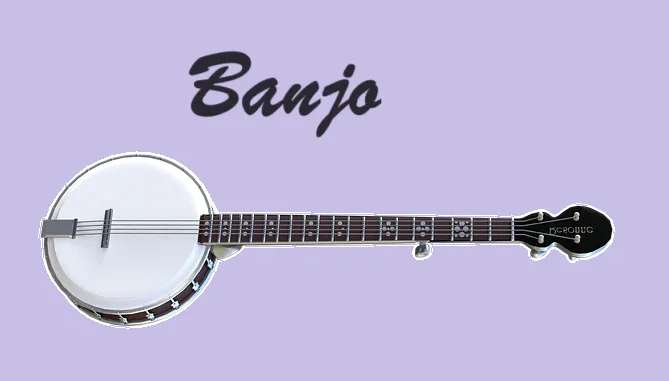
The banjo is a fascinating and beloved musical instrument known for its bright, twangy sound. Whether you’re a seasoned musician or a beginner looking to explore new horizons, the banjo offers a unique and rewarding musical experience. In this comprehensive guide, we’ll dive into everything you need to know about the banjo instrument—from its rich history to the various types, how to play it, and even where to find a banjo instrument for sale.
What Is a Banjo?
A banjo is a stringed musical instrument with a thin, circular body covered by a drum-like membrane. This design is responsible for its distinct, resonant sound. Banjos typically have four, five, or six strings that are played by plucking or strumming. The instrument is widely used across genres like bluegrass, folk, country, and jazz.
What Makes the Banjo Unique?
The banjo stands out due to its:
- Bright, Percussive Sound: The drum-like membrane amplifies the sound, making it loud and clear.
- Versatility: You can find banjos in diverse music genres.
- Playability: Many beginners find it easier to learn than other stringed instruments.
History of the Banjo
Where Did the Banjo Originate?
The banjo has its roots in West Africa. Early versions of the instrument were crafted from gourds with animal skins stretched over the top. During the 17th century, African slaves brought the instrument to America, where it evolved into the modern banjo we know today.
When Was the Banjo Invented?
While the banjo’s exact date of invention is unknown, historians trace its origins back over 300 years. By the 1800s, the banjo became a central instrument in American folk and bluegrass music. African American musicians played a crucial role in its popularization.
Types of Banjos
If you’re interested in banjo instruments, it’s essential to know the different types available. Each variety has unique characteristics and suits specific music styles.
4-String Banjo
- Usage: Common in jazz and Irish folk music
- Sound: Bright and punchy
5-String Banjo
- Usage: Most common type, especially in bluegrass
- Sound: Traditional, twangy sound
6-String Banjo
- Usage: Played like a guitar, but sounds like a banjo
- Sound: Warm, with a guitar-like playability
Tenor Banjo
- Usage: Popular in traditional jazz
- Sound: High-pitched, ideal for rhythmic chording
Plectrum Banjo
- Usage: Similar to the tenor but with a longer neck
- Sound: Rich, full-bodied tone
How to Play the Banjo
Basic Techniques for Beginners
- Fingerpicking: Most banjo players use a three-finger picking style called “rolls.”
- Strumming: Simpler than fingerpicking, perfect for beginners.
- Chords: Learning a few basic chords allows you to play many songs.
How Long Does It Take to Learn the Banjo?
- Beginner Level: 3 to 6 months for basic rolls and chords.
- Intermediate Level: 1 to 2 years to play full songs.
- Advanced Level: 3+ years to master complex techniques.
Why Play the Banjo?
The banjo is more than just a musical instrument—it’s a gateway to musical exploration and creativity. Here are a few reasons to pick up a banjo:
- Unique Sound: No other instrument replicates its twangy resonance.
- Versatility: Fits perfectly in various genres.
- Fun to Play: The learning process is engaging and rewarding.
Famous Banjo Players
Many musicians have mastered the banjo instrument and helped elevate it to global fame. Some of the most iconic banjo players include:
- Earl Scruggs: Pioneer of the “Scruggs style” three-finger picking technique.
- Béla Fleck: Known for blending banjo music with jazz and classical.
- Steve Martin: Comedian and accomplished bluegrass banjo player.
How Much Does a Banjo Cost?
Whether you’re a beginner or a professional, there’s a banjo for every budget. Here’s a rough guide to banjo instrument for sale prices:
- Beginner Banjos: $150 – $400 (ideal for new players)
- Intermediate Banjos: $400 – $1,000 (better materials and sound quality)
- Professional Banjos: $1,000 – $3,000+ (premium craftsmanship and tonal precision)
Popular Banjo Brands:
- Deering: Known for high-quality craftsmanship.
- Gibson: A legacy brand in banjo-making.
- Gold Tone: Excellent for mid-range and beginner options.
Caring for Your Banjo
Maintaining your banjo ensures it lasts for years. Follow these simple tips:
- Clean Regularly: Wipe down the strings and body after each use.
- Store Properly: Keep your banjo in a case to protect it from dust and moisture.
- Tune Often: Regularly check and adjust the tuning for the best sound.
Where to Buy a Banjo
You can find banjo instruments for sale at various locations:
- Local Music Stores: Check for hands-on experience.
- Online Retailers: Websites like Amazon and eBay offer a range of options.
- Specialized Makers: Brands like Deering and Gold Tone sell directly to consumers.
Fun Facts About Banjos
- The world’s fastest banjo player can play over 210 notes per minute.
- The banjo was a staple instrument during the American Civil War.
- Banjos were once known as “banjers” in Southern dialects.
Conclusion
The banjo is a captivating instrument with a deep cultural heritage and an unmistakable sound. Whether you’re exploring its origins, learning to play, or looking for a banjo instrument for sale, there’s no better time to embrace this remarkable instrument. With patience and practice, you could soon be strumming along to your favorite bluegrass tunes or even creating your own music.
Frequently Asked Questions (FAQs)
Is the banjo hard to learn?
No! With regular practice, beginners can quickly learn basic chords and rolls.
How many strings does a banjo have?
Banjos typically have 4, 5, or 6 strings, with the 5-string being the most common.
How much does a banjo cost?
Prices range from $150 for beginners to $3,000+ for professionals.
Where can I buy a banjo?
You can purchase a banjo from local music stores, online retailers, or specialized manufacturers.
Start your banjo journey today and enjoy the rich sounds and stories this unique instrument has to offer!
Leave a Reply